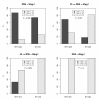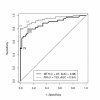Mild therapeutic hypothermia alters neuron specific enolase as an outcome predictor after resuscitation: 97 prospective hypothermia patients compared to 133 historical non-hypothermia patients
- PMID: 20403168
- PMCID: PMC2887191
- DOI: 10.1186/cc8975
Mild therapeutic hypothermia alters neuron specific enolase as an outcome predictor after resuscitation: 97 prospective hypothermia patients compared to 133 historical non-hypothermia patients
Abstract
Introduction: Neuron specific enolase (NSE) has been proven effective in predicting neurological outcome after cardiac arrest with a current cut off recommendation of 33 microg/l. However, most of the corresponding studies were conducted before the introduction of mild therapeutic hypothermia (MTH). Therefore we conducted a study investigating the association between NSE and neurological outcome in patients treated with MTH.
Methods: In this prospective observational cohort study the data of patients after cardiac arrest receiving MTH (n = 97) were consecutively collected and compared with a retrospective non-hypothermia (NH) group (n = 133). Serum NSE was measured 72 hours after admission to ICU. Neurological outcome was classified according to the Pittsburgh cerebral performance category (CPC 1 to 5) at ICU discharge.
Results: NSE serum levels were significantly lower under MTH compared to NH in univariate analysis. However, in a linear regression model NSE was affected significantly by time to return of spontaneous circulation (ROSC) and ventricular fibrillation rhythm but not by MTH. The model for neurological outcome identified NSE, NSE*MTH (interaction) as well as time to ROSC as significant predictors. Receiver Operating Characteristic (ROC) analysis revealed a higher cutoff value for unfavourable outcome (CPC 3 to 5) with a specificity of 100% in the hypothermia group (78.9 microg/l) compared to the NH group (26.9 microg/l).
Conclusions: Recommended cutoff levels for NSE 72 hours after ROSC do not reliably predict poor neurological outcome in cardiac arrest patients treated with MTH. Prospective multicentre trials are required to re-evaluate NSE cutoff values for the prediction of neurological outcome in patients treated with MTH.
Figures





Similar articles
-
Use of S-100B, NSE, CRP and ESR to predict neurological outcomes in patients with return of spontaneous circulation and treated with hypothermia.Emerg Med J. 2016 Oct;33(10):690-5. doi: 10.1136/emermed-2015-205423. Epub 2016 Jun 10. Emerg Med J. 2016. PMID: 27287003
-
S-100B is superior to NSE, BDNF and GFAP in predicting outcome of resuscitation from cardiac arrest with hypothermia treatment.Resuscitation. 2011 Jan;82(1):26-31. doi: 10.1016/j.resuscitation.2010.10.011. Epub 2010 Nov 10. Resuscitation. 2011. PMID: 21071131
-
Serial measurement of neuron specific enolase improves prognostication in cardiac arrest patients treated with hypothermia: a prospective study.Scand J Trauma Resusc Emerg Med. 2012 Jan 29;20:6. doi: 10.1186/1757-7241-20-6. Scand J Trauma Resusc Emerg Med. 2012. PMID: 22284447 Free PMC article.
-
Serum Neuron-Specific Enolase Thresholds for Predicting Postcardiac Arrest Outcome: A Systematic Review and Meta-analysis.Neurology. 2022 Jan 4;98(1):e62-e72. doi: 10.1212/WNL.0000000000012967. Epub 2021 Oct 18. Neurology. 2022. PMID: 34663643
-
Prognostication of neurologic outcome in cardiac arrest patients after mild therapeutic hypothermia: a meta-analysis of the current literature.Intensive Care Med. 2013 Oct;39(10):1671-82. doi: 10.1007/s00134-013-3004-y. Epub 2013 Jun 26. Intensive Care Med. 2013. PMID: 23801384 Review.
Cited by
-
Neurofilament light as an outcome predictor after cardiac arrest: a post hoc analysis of the COMACARE trial.Intensive Care Med. 2021 Jan;47(1):39-48. doi: 10.1007/s00134-020-06218-9. Epub 2020 Aug 27. Intensive Care Med. 2021. PMID: 32852582 Free PMC article.
-
Blood-brain barrier disruption as a cause of various serum neuron-specific enolase cut-off values for neurological prognosis in cardiac arrest patients.Sci Rep. 2022 Feb 9;12(1):2186. doi: 10.1038/s41598-022-06233-4. Sci Rep. 2022. PMID: 35140324 Free PMC article.
-
Improved early postresuscitation EEG activity for animals treated with hypothermia predicted 96 hr neurological outcome and survival in a rat model of cardiac arrest.Biomed Res Int. 2013;2013:312137. doi: 10.1155/2013/312137. Epub 2013 Dec 4. Biomed Res Int. 2013. PMID: 24369012 Free PMC article.
-
Secretoneurin as a marker for hypoxic brain injury after cardiopulmonary resuscitation.Intensive Care Med. 2014 Oct;40(10):1518-27. doi: 10.1007/s00134-014-3423-4. Epub 2014 Aug 20. Intensive Care Med. 2014. PMID: 25138227
-
Single versus Serial Measurements of Neuron-Specific Enolase and Prediction of Poor Neurological Outcome in Persistently Unconscious Patients after Out-Of-Hospital Cardiac Arrest - A TTM-Trial Substudy.PLoS One. 2017 Jan 18;12(1):e0168894. doi: 10.1371/journal.pone.0168894. eCollection 2017. PLoS One. 2017. PMID: 28099439 Free PMC article. Clinical Trial.
References
-
- Pfeifer R, Borner A, Krack A, Sigusch HH, Surber R, Figulla HR. Outcome after cardiac arrest: predictive values and limitations of the neuroproteins neuron-specific enolase and protein S-100 and the Glasgow Coma Scale. Resuscitation. 2005;65:49–55. doi: 10.1016/j.resuscitation.2004.10.011. - DOI - PubMed
-
- Meynaar IA, Oudemans-van Straaten HM, Wetering J van der, Verlooy P, Slaats EH, Bosman RJ, Spoel JI van der, Zandstra DF. Serum neuron-specific enolase predicts outcome in post-anoxic coma: a prospective cohort study. Intensive Care Med. 2003;29:189–195. - PubMed
-
- Schoerkhuber W, Kittler H, Sterz F, Behringer W, Holzer M, Frossard M, Spitzauer S, Laggner AN. Time course of serum neuron-specific enolase. A predictor of neurological outcome in patients resuscitated from cardiac arrest. Stroke. 1999;30:1598–1603. - PubMed
Publication types
MeSH terms
Substances
LinkOut - more resources
Full Text Sources
Medical

